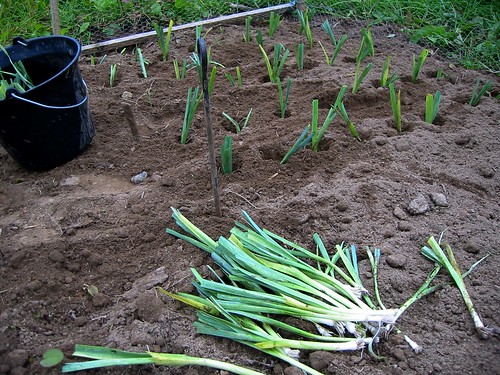
At the weekend we bought a bunch of leeks for transplanting from the market at St. Lo.
Leeks are big business in Normandy, the local sandy soil is ideal for their production and along with carrots nearly every market gardener and small holder relies on them for a cash crop. About 30km north west of here is the town of Carentan which has given its name to a famous leek variety 'Monstreux de Carentan' famed all over the region (and available in the UK amongst other places) for its hardiness and tubby growth. My bunch of over 100 transplants, I had 115 but some were a bit weedy, set me back 5 euros, pretty cheap for the leeks to come from them and a bargain for me. I'm a poor mother in the nursery bed and rarely get my charges started in time, let alone bring them to a point where they can take their places in the proper potager.
It's a little bit late to be setting leeks out but I can't be the only one, there were queues of eager French gardeners collecting their bunches along with endives, lettuces, kale and cabbage seedlings.
Traditionally one trims the roots of leeks. This is falling out of fashion and you may read that it is unnecessary, even counter productive since it sets the plants back but it does little harm and does allow the young plants to be dropped into their deep planting holes with a chance of getting their feet in the soil. Because trimming roots does slow down the uptake of moisture for a while I also trim the leaves back to reduce the burden of transpiration, very important in hot weather.
Use a strong dibber - I use a poker but it's a bit narrow - to make holes 15-20cm apart in rows about 30cm apart. How deep you make them depends on the quality of your soil and what sort of leeks you like. Because I'm only interested in cooking a fairly short blanched white stem suits me so I make the holes about 15cm deep.
Pop a plant into each hole making sure it reaches the bottom with its roots but that it is straight in the hole. They're very difficult to pull if the stem gets kinked. Don't fill the hole but use a watering can to puddle into each depression with enough water to fill it. As the water drains down it will settle the soil over the roots and the plant will grow thick and strong in the loosened soil and space left for it.
The leeks will continue to grow whenever conditions are warm enough to permit it and they are very hardy. I expect to start pulling these in November and continue through until the last few come out at the end of March, one of the benefits of a mixed bag of seedlings.
To protect them from rampaging deer I've re-erected a 'cage' we constructed last summer. It's not sturdy but it should give those pesky deer the hint. These leeks are not for them to eat.
2 comments:
I do my leeks the same way and it works for me. My neighbours also advocate the same for transplanting onions and lettuces believe it or not. I can't bring myself to hack down baby lettuces but the alliums get the chop before planting.
Great site you've got here my first visit and I'll be back.
Hi Laura,
Thanks for the kind words.
Poor baby lettuces. You've got to be cruel to be kind!
Post a Comment